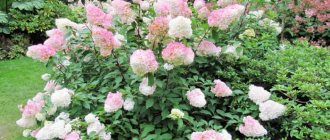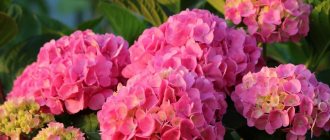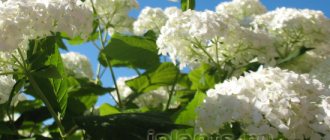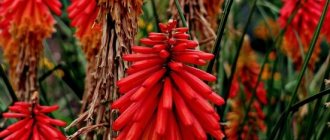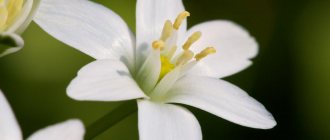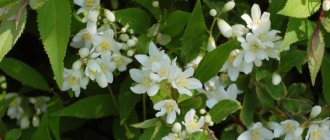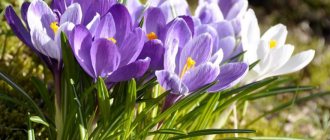- April 19, 2019
- Flowers
- Kristina Degtyareva
Paniculate hydrangeas have long gained popularity among gardeners around the world. Which is not surprising, because these shrubs look just great, and caring for them is not particularly difficult and does not take much time. The heroine of our article today is the delightful hydrangea paniculata Vanilla Fraze. Planting and care, biological description are presented below. Please note: this variety is quite in demand in the southern regions of our country, but experienced gardeners achieve excellent results even in the northern regions.
History of appearance
Vanilla Fraze was developed in France. The breeding was carried out by specialists from a nursery called Renault. The first work began back in 1989. The breeders were faced with a rather difficult task - they had to get a hydrangea that would quickly change its delicate white color to pink. As a result, several plants were obtained. But the final choice fell on Vanille Fraise hydrangea. This happened in 2003.
Winter protection
Varietal hydrangea Vanilla Fraze overwinters in open ground conditions without shelter throughout the middle zone. However, the shrub may freeze if there is insufficient snow cover on the soil, so it is recommended to insulate the plant for the winter season. Young bushes up to 5 years old are also covered for the winter.
For shelter, you should make a 10 cm thick mound of peat around the bush and carefully bend the branches to the ground, securing them with wire. The outside of the hydrangea is covered with spruce branches or straw and covered with polyethylene.
Hydrangea Vanille Fraise harmonizes well and gets along with conifers, peelings, phlox, and knotweed. The shrub is ideal as a hedge and looks amazing as a separate plant in the garden. Unpretentious in care, hydrangea can become the center of attention of every gardener's plot.
Biological description of hydrangea Vanilla Fries and photo
This name fully justifies the color scheme of the inflorescences - a combination of white and deep pink shades. The word fraise can be translated from French as “strawberry”. So what is Hydrangea paniculata Vanilla Fraze? The description is amazing: it is a spreading shrub with powerful and elastic shoots, the height of the plant on average reaches from one and a half to two meters. The shoots have a rich burgundy hue. Along the entire length of the branches there are neat oval leaves.
Hydrangea blooms begin in June and can continue until mid-November. The inflorescences are characterized by a pyramidal shape, each about 30 centimeters long. At the same time, initially the petals are white, but closer to August, hydrangea flowers become bright pink. At the beginning of autumn, the pink tone changes to burgundy-red. The plant blooms in the first year after planting in the ground.
Description of the rose Vanille Fraise
Vanilla Frize is a very beautiful variety of hybrid tea rose that will charm you with its two-color flowers. The flowers are beautifully cup-shaped and have a medium fruity scent. The flower is large, 10-11 centimeters in diameter, dense, with about 50 petals, which are light beige in color with red uneven strokes. A shrub with emerald leaves grows to a height of 250-300 cm. The flowers on the stems are single or collected in inflorescences of up to 3 pieces. Flowering is repeated and abundant.
The main characteristics of the Vanilla Frase rose:
- Large-flowered;
- Variegated and bright, very noticeable among other roses in the garden;
- Has a long flowering period;
- Average disease resistance;
- Frost-resistant.
Rose Vanilla Fries is ideal for rose gardens and looks beautiful in groups or alone. Pairs well with other annuals, perennials and herbaceous plants.
Selection of seedlings
Have you decided to plant Vanilla Fraze hydrangea in your garden? Planting and care are very important stages, but there is something more important. This is the choice of seedling! It depends on which plant you choose how it will bloom and whether it will decorate your site. First of all, you should pay attention to the fact that seedlings on sale come with an open or closed root system. Of course, plants with bare roots are cheaper, but they take root less well. Hydrangea roots should be strong, free of damaged areas and mold.
Application in landscape design
In landscape design, Vanilla Fraze hydrangea is used very often. Experts like the large size of their inflorescences, long flowering, and the color of the petals changing during flowering, which gives the plant additional decorativeness.
The plant is a tall plant, so hydrangea shrubs are used as the main background, planted in the background of flower beds (or in the center). And low flowers are planted in the foreground or along the edges.
These abundantly flowering perennials are also used as a hedge, planted along the perimeter of the site, near the entrance to the country house. These perennials look beautiful near gazebos or open terraces.
The beauty of Vanilla Fraze hydrangea is enhanced by coniferous shrubs and trees planted nearby.
Choosing a place in the garden
In order for Vanilla Fraze to take root on the site and delight with lush flowering for a long time, it is important not only to select seedlings, but also to choose a suitable place. A number of factors should be taken into account: lighting, the presence of other bushes or trees nearby, the presence or absence of wind protection. The ideal option for this variety of hydrangea would be shaded areas, because bright sunlight slows down the growth of the plant and the inflorescences become small.
If your garden does not have a shady area, you can plant hydrangea in the sun, but it will be important to water it frequently and abundantly. Young plants need careful protection from the wind. For such purposes, any buildings, fences or low trees are suitable. You should not plant Vanilla Fraze hydrangea under trees, which absorb all the water. In the northern regions and the middle zone, gardeners recommend planting shoots on the south side.
Planting a plant in open ground
Choosing a place and time of landing
The requirements for choosing a planting site for Vanilla Fries are for the most part the same as for all paniculate hydrangeas. This:
- protection from wind and drafts;
- distance from plants with a shallow root system;
- undesirable proximity to fruit trees (apple tree, pear tree and others);
- deep groundwater (more than 1.5 m);
- absence of crops in the root circle zone that require annual digging.
Of the listed conditions for the variety in question, the most relevant is protection from wind, which the crop absolutely cannot tolerate.
The light requirements of Vanilla Fries are not as high as those of other hydrangeas, and are largely determined by the climate zone. In the southern regions, shading is necessary during the midday hours, and best of all, diffused sunlight during the day. For northern latitudes, on the contrary, the preferred option is one with full lighting, which compensates for the lack of heat.
Both excess and lack of illumination negatively affect, first of all, the quality of the inflorescences - their appearance, size and color saturation. In partial shade, the variety exhibits maximum decorativeness - huge and long-blooming inflorescences with a slow color change.
The optimal time for planting is late April - early May. During this period, warm weather sets in in most regions of the country and the earth is already quite warm (up to 10-12°C). During the summer season, the crop, as a rule, takes root well and gains strength to safely survive the winter cold.
In the south, planting work is possible in early autumn.
Soil preparation and planting work
For the successful growth of Vanilla Fries hydrangea, certain requirements are imposed on the soil. It should be fertile (preferably loam), loose, with good air and water permeability. The most significant characteristic of soil for hydrangea crops is its acidity level. Soil with acidity (pH 5.0-5.5) is favorable for Vanilla Fries. However, a neutral version of the acid-base balance (pH 7) is also acceptable for the plant.
Sandy and calcareous soils are contraindicated for this variety.
An important step before planting a crop in open ground is to check its characteristics for pH level. Soil acidification can be achieved using natural ingredients (peat, humus). However, most of all the variety respects fallen needles.
It is prohibited to use dolomite flour, chalk, lime, ash, which contain calcium salts and contribute to the growth of alkaline characteristics of the soil.
The order of work when planting hydrangeas in open ground is as follows:
- A few days (one and a half, two weeks) before the main work, dig holes 2 times larger than the root system of the seedling.
- To prevent stagnant processes, a drainage layer of about 10 cm is lined at the bottom of the hole. For this purpose, you can use the material available in the garden: broken bricks, crushed stone, pebbles and the like.
- Prepare a soil mixture from the following ingredients in proportion :
- turf soil - 2 parts;
- peat - 2 parts;
- compost - 1 part;
- sand - 1 part.
A good option would be to use purchased ready-made soil for hydrangeas.
- The prepared substrate is poured into the planting hole on top of the drainage layer to an average of a third of its depth.
- Fertilizers with a high content of phosphorus and potassium are applied to the hole. For example, superphosphate - 50 g, potassium sulfate - 30 g.
- Water the hole for better penetration of nutrients into the soil and leave it alone.
- On the day of planting, the hole is watered with water with the addition of citric acid (5-10 g per bucket).
- Place the seedling in the hole, distribute the roots evenly, cover it with previously prepared soil and compact it. In this case, the root collar should be on the surface.
- Once again, water the seedling abundantly (on average, a bucket per bush).
- Lay out a mulching layer (peat, sawdust, pine needles, etc.).
When planting several crops at the same time, a distance of at least 1.5 m should be left between them. Young plants need protection from wind and direct sunlight.
Soil selection and preparation
Sandy soil is completely unsuitable for this hydrangea, because in it the plant will not receive the nutrients it needs in the required quantity. The best option is neutral soil, but slightly acidic soil is also suitable. If it is still sandy, peat and a large amount of humus should be added to it - this way the soil will retain moisture. Coniferous litter should also be added to any soil. But it is not recommended to use lime, chalk, or ash.
Planting hydrangea
A suitable place is being prepared for planting paniculate hydrangea Vanilla Fraze. Be sure to take into account its illumination, the presence of protection from the wind, and its location relative to trees and other shrubs. Before planting, the soil is improved by adding the necessary components.
Preparatory stage
Paniculata hydrangea is planted in partial shade. In the middle zone and to the north, the bush is located on the southern side of the site. With constant exposure to the sun, the inflorescences will lose their decorative effect.
Hydrangea Vanilla Fraze should not be exposed to cold winds. Buildings, fences or trees can act as protection against wind loads.
Important! Panicle hydrangea prefers fertile loam.
In sandy soil, the shrub does not receive the required amount of nutrients. To make the soil retain moisture better, peat and humus are added to it.
The Vanilla Fraze variety prefers slightly acidic or neutral soil. Therefore, before planting, it is recommended to add pine litter to the substrate. To successfully grow hydrangea, the use of lime, chalk, dolomite flour and ash should be completely abandoned.
Work order
Paniculata hydrangea is planted in the spring before sap flow begins. It is possible to postpone work to the autumn period (September or October). The shrub needs to be planted after leaf fall, before frost begins.
Planting material is purchased from nurseries. Be sure to choose healthy seedlings without signs of damage or rotting. The optimal shoot height is 30 cm.
The procedure for planting paniculate hydrangea Vanilla Fraze:
- In the selected bed, dig a hole measuring 30x30 cm.
- When planting several bushes, maintain 1 to 2 m between them.
- Then they begin to prepare the substrate: mix turf soil, peat, compost and sand in a ratio of 2:2:1:1.
- 50 g of superphosphate and 30 g of potassium sulfate are added to the substrate. To deoxidize the soil, fallen pine needles are used.
- The prepared substrate is poured into the hole.
- Within 1-2 weeks the soil will settle, and you can begin preparing the seedling. The plant is removed from the container, its roots are trimmed and dipped in a growth stimulator for 2 hours.
- Hydrangea is planted in a hole. Its roots are straightened and covered with earth.
- The plant is watered abundantly with soft water.
Young hydrangea bushes are watered regularly. To protect from the sun in hot weather, a canopy is installed over them.
Hydrangea Vanilla Fraze: description of the planting process
Experts recommend planting paniculate hydrangeas of any variety before sap flow begins, in the spring. Autumn planting is also allowed - after leaf fall, but before frost begins.
Boarding order:
- You need to choose a suitable location. A few weeks before planting the shoots, dig a hole, the diameter of which should be 30 centimeters. If you plan to plant several shrubs, maintain a distance of about 1.5–2 meters between them.
- Prepare a special substrate for Vanilla Fraze hydrangea - combine two parts of turf soil and peat with one part of compost and the same amount of sand. Add superphosphate (one plant will need 50 grams) and potassium sulfate (30 grams). To deoxidize the soil, you should add fallen pine needles to it.
- The next stage is pouring the substrate into the hole.
- After one and a half to two weeks, when the soil has settled a little, you can plant hydrangea. The roots of the seedling should be trimmed and then dipped in any growth stimulator for two hours.
- Hydrangea Vanilla Fraze is ready to plant. Place it in the hole, straighten the roots thoroughly and carefully cover it with soil. Water the plant immediately after this.
History and description of the variety
Hydrangea paniculata Vanille Fraise was bred in a French nursery by its president and became a prize-winner at exhibitions in Holland and France. The advantages of the variety lie in the unique shade transition of the largest inflorescences from white to pink, in the duration and abundance of flowering.
Description of culture:
| Plant type | bush |
| Height | 1.5–2 m |
| Annual growth | up to 25 cm |
| Inflorescence shape | broadly pyramidal racemose, consisting of many small flowers |
| Hue | flowers are white at first, then pink below, darkening to crimson in autumn |
| Flowering duration | July–September (October) |
| Leaves | dense ovoid, slightly pubescent, dark green |
| Escapes | straight, brown, bending under the weight of the hands |
| Roots | branched |
Watering
Like any paniculate hydrangeas, Vanilla Fraze is moisture-loving, and therefore watering should not be skipped. It is recommended to moisten the soil under the bush at least once a week, but this can be done more often if the soil dries out and a hard crust forms on the surface. About ten liters of water need to be poured under one plant. It should be warm and settled. Please note: the root system of hydrangeas is located too close to the surface, and therefore when watering you should make sure that they are not exposed. Immediately after watering, procedures such as loosening and hilling should be carried out. Before a prolonged drought, it is recommended to mulch the soil with humus or peat.
Agricultural care technology
Agrotechnical measures after planting a seedling and in subsequent years can hardly be called complex: watering, loosening or mulching, fertilizing, pruning shoots, preparing for wintering. Features of agricultural technology of care are available.
Therefore, let’s take a closer look at caring for Vanilla Fraze hydrangea:
- Watering. The shrub requires abundant and regular watering. Warm, settled water is used to irrigate young bushes. Adult bushes are watered with water at the rate of 1 specimen - up to 12 liters. Irrigation frequency is every 6-8 days. If the summer turns out to be dry, with virtually no rain, then water the bush every other day. It is unacceptable to water so that the roots of the plant are exposed (if this happens, the hydrangea trunk is hilled up);
- Loosening the soil. After each watering, you need to carefully aerate the soil to destroy the soil crust and give oxygen access to the root system;
- Mulching. Most often, after planting, the tree trunk area is mulched. Then there is no need for loosening. Mulch should be changed once every 2 months;
- Fertilizer. This is an important point in agricultural technology for caring for ornamental crops. Therefore, we will consider all stages of fertilizing in more detail.
Table 1.2 Fertilizer application for Vanille Fraise bushes
| Deadlines | What should I contribute? |
| April 9-20 | Nitrogen fertilizers, organic matter for increasing green mass. |
| April 5 – May 30 | A pinkish solution of manganese is used, which is sprayed onto the bush to make the shoots flexible. |
| June 1-20 | Potassium, superphosphate or mineral complex |
| July 1-25 | Mineral fertilizers, organic matter at the root during watering |
| August 1-25 | Lactic acid for soil acidification. |
| September 1-16 | Micro- and macroelements: potassium, phosphorus, boron. Adding elements will help lay flower buds for next year. |
Rules for pruning ornamental shrubs
Vanilla Fraze hydrangea is pruned every year in the fall. Some experts do not recommend pruning bushes in the spring, except for removing shoots damaged during wintering.
Features of autumn pruning:
- held in the 3rd ten days of October;
- weak shoots older than 3 years of age are cut off;
- branches that greatly thicken the bush are removed;
- strong and young shoots are shortened by 10-15 cm.
The first inflorescences of Vanilla Fraze are formed 1-2 years after planting the bush in open ground.
But gardeners recommend pinching off the buds so that all efforts are directed to the growth of shoots.
For an adult bush, it is advisable to carry out anti-aging pruning. During the procedure, all shoots are cut out, except for 10-12 young branches. This pruning is carried out only before the start of sap flow.
Video about proper trimming:
Fertilizer application
What other procedures are important for shrubs after planting? Hydrangea Vanilla Fraze and its care cannot be imagined without feeding. Nutrients such as organics or mineral complexes are best. Gardeners recommend alternating different types of fertilizers. There is a scheme that should be followed when feeding paniculate hydrangeas:
- kidney swelling;
- the appearance of buds;
- mass flowering;
- preparation for cold weather.
The first feeding, which is carried out at a time when the hydrangea's buds are gaining strength, should be organic. For one part mullein you will need 15 parts water. This solution should be watered directly to the roots of the bushes.
For summer feeding, you should choose mineral complexes. You can purchase ready-made formulations or prepare the fertilizer yourself. This will require 30 grams of potassium salt, ammonium nitrate and superphosphate. The resulting mixture should be dissolved in water. In the fall, it is necessary to “pamper” the plant with potassium sulfate and superphosphate - 30 grams per bush. Please note: before winter you should not apply nitrogen-based fertilizers - otherwise the Vanilla Fraze hydrangea will begin to grow vigorously.
Caring for Vanilla Fraze
By regularly caring for Vanilla Fries, you can contribute to the formation of lush inflorescences. This perennial variety requires timely application of fertilizers and soil moisture. By trimming the shoots you can form the desired shape of the plant.
Hydrangea Great Star paniculata
To protect bushes from diseases, you can use special preparations or folk remedies.
Soil moistening
The paniculate hydrangea variety Vanilla Frazee loves moisture. The soil under the bush must be moistened every 5-7 days. Under no circumstances should the soil be allowed to dry out and a crust to form on the surface of the earth.
Note ! Under each bush it is necessary to add 10-12 liters of water every 5-7 days. Pre-settled water should be at room temperature.
During particularly dry periods, the bush is watered every other day. The roots are located near the surface of the soil, so it is important to pay attention to them. During watering, the root system should not be exposed. After 10 liters of water have been poured under the hydrangea, it is necessary to start hilling the hydrangea paniculata Vanilla Fraze. To moisten the soil less often, you can mulch the soil with peat or humus.
Feeding
In order for lush inflorescences to form on Vanilla hydrangeas, it is necessary to ensure a systematic supply of nutrients to the soil. It is best to use an organic or mineral complex for this purpose. Experienced gardeners recommend alternating both types of feeding.
The paniculate perennial especially needs feeding:
- in the spring at the time of swelling of the buds;
- during the period when the first buds appear;
- at the moment of mass flowering;
- in the autumn months, when the bushes are prepared for winter.
For the first feeding, it is best to use organic fertilizer, the basis of which is mullein. Organics combine with water (1:15). The solution is thoroughly mixed and poured under the plant bush.
In summer, the perennial is fertilized with mineral complexes. You can prepare the fertilizer yourself. To do this you will need to use:
- superphosphate;
- potassium salt;
- ammonium nitrate.
The listed substances, taken in equal proportions, dissolve in water.
Note ! If desired, you can purchase a special organic fertilizer complex, which is intended for paniculate types of hydrangea.
In autumn, a mixture of superphosphate and potassium sulfate must be added to the soil. In order not to provoke increased growth of shoots before winter, it is better to avoid using nitrogenous fertilizers in the fall.
Feeding Vanilla Fraze
Trimming
Thanks to pruning, the bush can be given the desired shape. Pruning should be done in the spring months before sap flow begins. Dried and broken branches must be removed. Shoots can be shortened to 7-8 buds.
Important ! In order to rejuvenate this plant, it is necessary to trim the shoots to the roots. Branches, the length of which reaches 8-10 cm, should remain above the surface.
Pruning should not be carried out during the summer months. At this time, it is better to remove dry inflorescences in order to speed up the process of the appearance of new buds.
Protection from diseases and pests
Hydrangea paniculata Vanilla Fraze is susceptible to fungal diseases that usually affect shoots and foliage. In order to cope with ailments, experts recommend using fungicides such as Fundazol, Topaz and Fitosporin. At the end of October, for the purpose of prevention, you can spray the bushes.
A deficiency of nutrients provokes the occurrence of chlorosis in the Vanilla Fraze variety. At the same time, the foliage begins to turn yellow and curl. To cope with the disease, you should apply a complex fertilizer that contains iron.
In order to cope with the invasion of snails, aphids and spider mites, it is necessary to spray the plant with an effective insecticide like Tanrek and Akarin. You can also use an infusion of onion peels. The folk remedy is used to treat bushes.
Paniculata hydrangea
Shelter for the winter
The paniculate variety of hydrangea (vanille fraise in Latin) is able to withstand severe winter frosts. Therefore, when growing a perennial in the southern region, you don’t have to cover the bushes for the winter. To protect flowers from freezing, you should use mulching using peat or humus. The recommended mulch thickness is 25-30 cm.
Note ! In other regions, it is necessary to cover the perennial with burlap or dense agrofibre. During snowfalls, snowdrifts are thrown over the bushes, which acts as an additional source of insulation.
Paniculate hydrangea Vanilla Fries is often used in landscape design. A chic plant that delights with abundant flowering can add zest and decorate any area. A tree-like flower is often used as the main background for low-growing flowers. Plants are also planted near rose garden arches.
Trimming
Pruning is necessary in order to give the lush, spreading shrub a neat shape. This event should be carried out in early spring, before the process of sap flow begins. First of all, dry and damaged branches should be removed. The next stage is pruning each shoot.
Pruning will also help to rejuvenate an adult hydrangea - 5-7 branches, the height of which is about 10 centimeters, should be left above the surface of the ground. In summer, paniculate hydrangea should not be trimmed, but dry inflorescences must be removed so that new buds appear.
Peculiarities
Vanilla Fraze has gained well-deserved popularity thanks to its decorative inflorescences of different colors and unpretentiousness.
Caring for hydrangeas of this variety includes the following activities:
- Regular watering. It is important not to allow the soil around the bush to dry out, as this can cause its death. In hot, dry weather, the amount of water must be significantly increased. The soil surface must be constantly moist. Watering is carried out 2 times a week in moderate weather conditions.
- Mulching and loosening. A prerequisite for good growth and development of hydrangeas is loosening the soil crust after each watering. Mulching with peat, pine litter, sawdust, and pine bark will help retain moisture.
- Trimming. Conduct annually in spring and autumn. The event will allow you to form a beautiful crown and also ensure abundant, long-lasting flowering. It is recommended to shorten young shoots, leaving no more than 5 buds. Remove inward, dried and old branches completely. Removing faded panicles will help maintain the decorative appearance of the shrub.
- Feeding. Apply the necessary complex fertilizers to the bush in a timely manner.
Vanilla Fraze is also grown as a houseplant, which is formed in the form of a trunk, up to 1 m high. As soon as the flower sheds its leaves in the fall, the container is left in a cool room where the temperature does not rise above 6 C. At the beginning of spring, the plant is transferred to the balcony or veranda.
The plant will decorate any personal plot or garden. Hydrangea is a crop with excellent decorative properties. In this case, the plant does not require special care. Panilla Vanilla Fraze requires regular watering, fertilization and pruning. It is enough to make a minimum of effort to decorate your garden plot with an incredibly beautiful plant.
Protecting plants from pests and diseases
Hydrangea Vanilla Fraze is quite resistant to diseases and pests. One of the few dangers is fungal diseases. If the summer is rainy and cool, the shrub may be affected by rot and powdery mildew. To protect hydrangea, you should promptly treat it with solutions prepared on the basis of fungicides. Gardeners recommend paying attention to such preparations as Topaz, Fundazol, Fitosporin. Hydrangea can also get sick if it lacks nutrients. In such a situation, chlorosis may begin. Identifying the disease is quite simple: it is characterized by symptoms such as yellowing of leaves, their curling and falling. Fertilizers that contain iron will help fight chlorosis.
Vanilla Fraze can attract various pests that feed on the sap of the bush. So if your hydrangea begins to dry out, its leaves fall off, and its growth slows down, check to see if the plant is infected with spider mites or aphids. It is possible that the hydrangea was attacked by snails. What to do if you find pests? First of all, you should use insecticides. “Akarin” and “Tanrek” are perfect. As a preventative measure, experts recommend using folk remedies - infusions prepared with garlic or onion peels.
Diseases and pests, control measures
Most diseases of this flowering shrub are caused by improper watering, which results in waterlogging of the soil. As a result, hydrangea is affected by downy mildew. The main signs of the disease are:
- the appearance of yellow spots on the foliage, which subsequently darken;
- A gray coating appears on the back of the leaves.
Important! To combat the disease, spraying with fungicidal preparations is used. The number of waterings should also be reduced.
Gray mold is another disease caused by fungi. As a result, small brown spots appear on the upper part of the leaf blades, which increase over time, merging into one large spot. All vegetative parts of the plant infected with rot should be immediately removed and burned. All plants are sprayed with the fungicidal preparation Rovral Flo 255 SC. Repeated treatment is carried out after 12-14 days.
Gray rot on hydrangea
If there is too much humus or lime in the soil, chlorosis may affect the hydrangea. Main signs of the disease:
- sharp lightening of the color of leaf plates with further yellowing;
- the veins on the leaf plates do not change their color;
- diseased leaves fall off.
In this case, preparations that increase its acidity (Antichlorosis, Ferovit) should be added to the soil.
Among the pests, this flowering perennial is attacked by spider mites or aphids. What to do in this case? Fufanon (or Thiophos) is effective against the first “harmful” bug. Aphids can be controlled by spraying foliage with a solution of Intavir or Actofit.
The drug "Intavir" against aphids
Preparing for winter
With proper care and preparation for cold weather, paniculate hydrangea of this variety can survive frosts down to -35 degrees! Therefore, in the southern zone, Vanilla Fraze does not need to be covered for the winter. Gardeners from central Russia or northern regions are recommended to protect the plant from freezing by mulching the soil. The thickness of humus or peat mulch should be at least 20 centimeters. In the first two years after planting, hydrangea should be covered with special agricultural material (burlap can be used instead). After snow falls, gardeners recommend throwing a small snowdrift over the bush in order to further insulate it.
Reproduction
There are two ways to propagate this delightful shrub. The first is cuttings. It should be carried out in the spring: you need to carefully cut off several shoots (of course, along with the buds), and then dip them in any growth stimulator. Immediately after this, the cuttings can be planted in a flowerbed, and after they take root, they can be planted in a permanent place. Another way is to use so-called layering. At the beginning of spring, the lower shoots should be cleared of leaves and secured to the ground, sprinkled with fertile soil. By autumn, the cuttings will have taken root, which means you can replant them.
